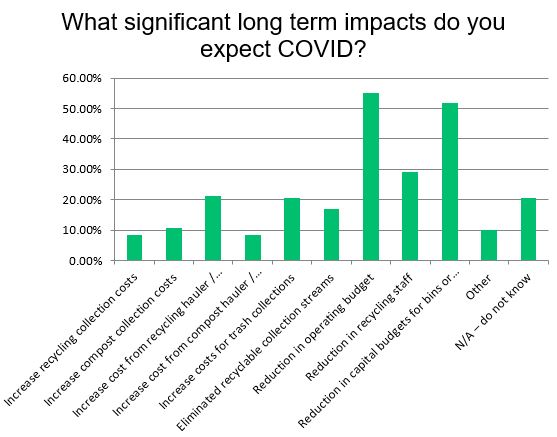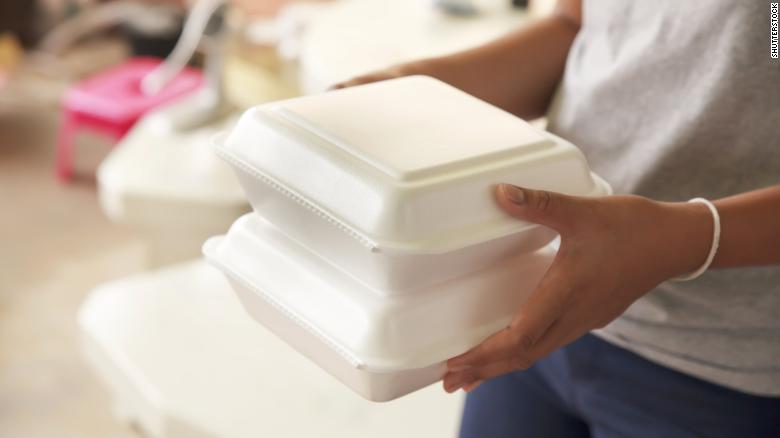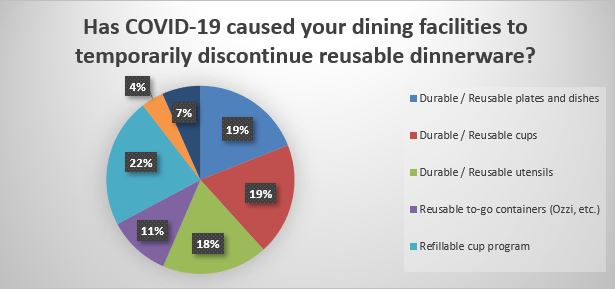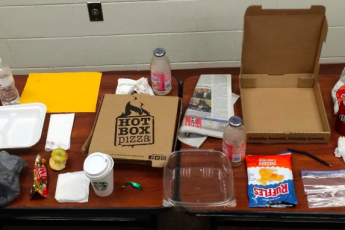The future was looking pretty murky for collegiate recycling and waste reduction programs in late-August when the College & University Recycling Coalition (CURC) and the US Composting Council (USCC) first surveyed campus recycling staff on the near-term impact of COVID-19 to recycling and organics recovery programs. With plans to return people to campus still a moving target, the survey pointed to a couple of broad trends: the need for a major reorganization of collection operations, a massive shift from reusable plates, cups, etc. toward disposable to-go packaging in dining operations, and above all, ominous signs of budget and staff cuts to come.
Around the same time, I was speaking to a number of managers for a previous blog I was working on. I had a question: did the turmoil caused by the pandemic have a possible silver lining? Click to read – “Could COVID-19 Lead to a Self-Service Revolution in Recycling” . I had a hunch and a few anecdotal examples, but a broader trend?
To find the answer to this and other long-term impacts, Busch Systems partnered with CURC, USCC, Zero Waste Campus Council and NRC Campus Council to conduct a follow-up part 2 survey in late October and November. Though changing conditions make it hard to predict in many cases, the goal of this second survey was to find early indications of how COVID-19 is influencing campus waste reduction efforts even after the pandemic passes. Among other topics, the survey asked questions about impacts to ongoing waste & recycling planning priorities, deskside and classroom collections, upstream procurement practices, and reusable dinnerware programs.
A diverse mix of 131 institutions have responded so far, ranging from well-known universities including Ohio State, Clemson, and Princeton to regional schools like Ivy Tech Community College in Indiana. Participating schools were distributed across the US and Canada, and included both 2-and 4-year institutions.
The preliminary results are now in and you can view highlights online . Schools that responded to the survey have access to the full results including individual responses from other colleges and universities. Schools that haven’t participated yet have a final two-week window to fill out the survey before it closes for good on January 22. The final results will become the basis for article submissions to recycling and higher education trade journals later this spring.
What Campus Recyclers Are Saying
Let’s start with some context and a caveat. Reflecting the national trend among higher ed institutions, most responding schools have a high percentage of students and staff working remotely. Three quarters said that 50% or fewer classes were taking place in-person, with more than half putting the number at 25% or less. With this in mind, many responses reflected policies or practices that are still in a state of flux or that are intended to go into effect when people return to campus in large numbers. And now the results…
Impact on Centralized / All-In-The-Hall Arrangements
My blog back in the fall theorized two possible impacts. The first was that the intense focus on cleaning surfaces and other pandemic-related factors were creating an opening to implement self-service-based centralized collection arrangements for offices. Whether influenced by the pandemic or other reasons, the survey shows clear evidence of changes taking place at office locations. 37 (28%) indicated they had entirely self-service based deskside collections or a hybrid of self-service and custodial service at the start of 2020. I suspect that number itself is significantly higher than even 5 years ago. Of the 62% of schools saying they had deskside custodial service for one or both streams at the outset, 17% said the pandemic had influenced the decision to shift toward self-service. Another 6% said decision-makers were giving it active consideration. A sample of 131 institutions is not enough to declare a broad trend, but the survey clearly suggests COVID-19 has opened a path to advance arrangements that place responsibility for emptying waste in the hands of staff and faculty. Message to recycling and sustainability managers: if you’ve been looking for the right timing to advocate this arrangement for your school, the iron is hot. Strike it.
Another question is how the pandemic will affect the trend toward removing waste bins from classrooms and meeting rooms. In the same spirit as the self-serve deskside system, this model relies on students and faculty to carry waste items out to centralized trash and recycling (and increasingly organics) bin stations in the hallway. And like self-serve deskside, consolidating a decentralized network of classroom waste baskets in favor of centralized stations has been shown to improve recycling rates and save housekeeping labor. The survey indicated an impressive 35% of schools had already or were in the process of transitioning to this “all-in-the-hall” system when the pandemic shut campuses down in the spring. But with wipe stations being added throughout academic buildings, 32% of these schools said they’d been forced, at least temporarily, to return waste baskets to classrooms to collect discarded wipes. With luck, this is a temporary setback that will reverse once the pandemic passes.
Budgets, Disposable Dinnerware & Changing Waste Streams
The survey puts hard numbers to what everyone already knows: the financial hit to state and university budgets is bringing hard times for recycling and waste reduction programs. Asked “what long term (beyond fall 2020 term), significant impacts do you expect”, 55% of respondents checked “reduction in operating budget”, 29% marked “reduction in recycling staff” and 52% indicated “reduction in capital budgets for bins or other infrastructure”. On top of these cuts, the survey suggests many are facing rising costs to handle waste material. Given a range of choices, anywhere from 9% to 22% of schools checked boxes saying COVID was leading to increased costs to haul and process recycling, organics, or trash. These impacts, of course, come on the heels of the ongoing recycling industry struggle with contamination and depressed recycling commodity prices in recent years.

For some schools, the situation means putting program upgrades on hold. Plans by Carnegie Mellon University to replace its entire residence hall recycling and waste bin infrastructure are on hold. The University of British Columbia is facing potential delays to vehicle replacement and improvements to its composting facility. For other schools, the impact is more dire. East Tennessee State is one of many schools having to drop money-losing materials from their recycling program. Texas Tech was hit with the worst scenario, a decision by housing administrators to eliminate its recycling program altogether.
Next to tightening budgets, the biggest impact of COVID 19 for many waste reduction programs has been the shift of most if not all dining to single-use, disposable food packaging. The part 1 survey conducted in August revealed that 62% of respondents had converted to exclusively take out / grab and go dining arrangement. The part 2 survey confirmed that over 50% continued to suspend the use of durable plates, cups, etc., and another 30% had at least temporarily discontinued the use of reusable Ozzie-style to-go container programs. Oklahoma State University’s Ilda Hersey made a succinct point echoed by others: “wash & reuse was unfairly given a bad rap at the start of COVID.” While these changes have mostly been labeled as temporary, the pandemic has the potential to reinforce the perception of many dining managers that single-use disposable packaging is the easier, hassle-free option. Recycling and sustainability advocates have and need to continue pushing back on the assumption that disposables are automatically safer than reusables. We’ll come back to this in a bit.

Though not asked as an explicit question, the “please explain” follow-up comments underline how the pandemic has changed waste stream composition and generation patterns. There are obviously fewer people to make waste, but they’re producing significantly more on a per capita basis –one school suggested twice or even three times as much. Lots of PPE to be sure. More cardboard and waste associated with online ordering. Electric hand dryers are being disconnected in favor of paper towels in restrooms. However, volume-wise, the real culprit for many schools is the disposable to-go food packaging coming out of dining and grab-and-go locations. Even as many are reducing overall collection service, schools including Colorado State and Arizona State said they were having to add new bins and pick-up routes for dining facilities and outdoor areas where people are going to eat socially distanced. (BTW – can I just wish a heartfelt good luck to RecycleMania this year? It was hard enough to get an apples-to-apples measure of per capita weights in a good year. This coming spring, ugh…). PPE and food packaging are particularly treacherous areas for the average person’s understanding of recyclability and compostability, and a number of schools cited their increased usage as the cause of growing contamination rates. Montana State is probably not alone in citing contamination as a reason for suspending post-consumer food collection.

Taken together, many campus recycling managers are feeling beleaguered. With all the challenges facing colleges, recycling and waste issues have become a low priority. 36% of the respondents checked the box indicating “cutbacks [were] reducing/preventing bandwidth for long term planning”. As Kimberly Hodge, Sustainability Director for Washington and Lee University wrote, “Planning and thinking long-term is harder now. It feels more like we’re working in a sort of an emergency room, where we only have time/energy to adjust to what is in front of us at the moment.”
Silver Linings
While times are tough for many, some program managers reported the opposite. Fewer people on campus has provided space to focus on the future. 18% included “Greater focus on long term operational planning” among their current priorities, and 16% checked the box for “Greater focus on new waste reduction/recovery initiatives.” Multiple people wrote comments similar to the University of Kentucky’s recycling coordinator, Joanna Ashford. “COVID has given us time to work on programs, foster relationships with other departments, and continue program planning.” This free time has allowed respondents to focus on a range of initiatives, including; reorganizing bin placement patterns (UCLA among others), evaluating waste generation patterns to optimize long term collection service (University of Ottawa), launching a special waste project for lab and research areas (North Carolina State University), study the potential for on-campus composting (Michigan State University), expanding hard-to-recycle collections for items like mattresses and film plastics (North Carolina State, Seattle University), and developing a sustainable purchasing plan and policy (Appalachian State University) among others. University of Nevada, Las Vegas’ recycling manager, Tara Pike was specifically asked by her supervisor to develop pilot projects that could be implemented during the pandemic.
In another “tale of two campuses” example of how schools are responding differently, the pandemic that shut down some Ozzie-style reusable food container programs is actually driving growth for others. Arizona State , University of Minnesota Duluth, Western Colorado University, and Lehigh University are just a few of the schools that have implemented or expanded programs this fall to reduce the tide of disposable food packaging. Rather than assume single-use disposables are safer than reusables, the main argument sustainability advocates have made is to focus on reducing actual touchpoints and implement well-thought-out protocols. After all, even disposable clamshells can get contaminated as dining employees unpack and pass servings to customers. Western Colorado had another good argument, that single-use packaging was contaminating recycling bins and in the process exposing workers forced to remove them by hand. Disposables aren’t necessarily safer, they simply transfer the risk to waste and recycling workers.
On the “upstream” side of waste reduction, comments left by Ohio State and another half dozen schools offer a tantalizing clue about a possible significant, long term change. For years IT departments have been cajoling staff, faculty, and students to make greater use of e-learning and project management platforms like Canvass and Microsoft Teams. Now that the pandemic has cut off millions of people from the convenience of their work printers and the ability to exchange paper documents, many are finding no choice but to trade printouts for the digital alternative. People will eventually return to campus, but behavior is largely dictated by habits. Could the interim train people to be more comfortable with electronic files? Like Spanish explorers searching for a lost city of gold, could the pandemic deliver to waste reduction advocates the long-rumored “paperless office”? Time will tell…
Include Your Campus With the Final Results
Thank you to all the schools that have participated in the survey to date. As I mentioned, we’re hoping to increase the number of school responses to make the findings more statistically representative. Higher ed institutions in the US and Canada that haven’t already completed the survey are encouraged to do so before the survey closes on Friday, January 22. Respondents will be able to read the responses from peer campuses (except those requesting to have their names withheld), as well as additional summary responses.
Finally, thank you to everyone involved with planning the survey, including Eric Halverson, Leana Houser, Jennifer Maxwell and BJ Tipton (CURC), Julie Muir (Zero Waste Campus Council), Linda Norris Waldt (US Composting Council), and Jack DeBell (NRC Campus Council).
Partial List of Schools Included in the Pt 2 survey
(Excludes schools that requested their names be omitted)
| Appalachian State University | Boone | NC |
| Arizona State University | Tempe | AZ |
| Auburn University | Auburn | AL |
| Brandeis University | Waltham | MA |
| Camosun College | Victoria | BC |
| Carnegie Mellon University | Pittsburgh | PA |
| Clark University | Worcester | MA |
| Clemson University | Clemson | SC |
| Colorado State University | Fort Collins | CO |
| Dawson College | Glendive | MT |
| Drexel University | Philadelphia | PA |
| East Tennessee State University | Johnson City | TN |
| Frostburg State University | Frostburg | MD |
| Haverford College | Haverford | PA |
| Hobart and William Smith Colleges | Geneva | NY |
| Indiana University, Bloomington | Bloomington | IN |
| Iowa State University | Ames | IA |
| Ivy Tech Community College – Evansville Service | Area Evansville | IN |
| Johns Hopkins University | Baltimore | MD |
| Johnson County Community College | Overland Park | KS |
| Kansas State University | Manhattan | KS |
| Kent State University | Kent | OH |
| Loyola Marymount University | Los Angeles | CA |
| Massachusetts Maritime Academy | Buzzards Bay | MA |
| Michigan State University | East Lansing | MI |
| Montana State University | Bozeman | MT |
| Muskegon Community College | Muskegon | MI |
| North Carolina State University | Raleigh | NC |
| Northland College | Ashland | WI |
| Oakton Community College | Des Plaines | IL |
| Ohio State | Columbus | OH |
| Oregon State University | Corvallis | OR |
| Portland Community College | Portland | OR |
| Portland State University | Portland | OR |
| Princeton University | Princeton | NJ |
| Salisbury University | Salisbury | MD |
| San Jose State University | San Jose | CA |
| Southern Connecticut State University | New Haven | CT |
| Spelman College | Atlanta | GA |
| Surry Community College | Dobson | NC |
| Texas A&M University Corpus Christi | Corpus Christi | TX |
| Texas Tech University | Lubbock | TX |
| The University of Texas at Austin | Austin | TX |
| University of British Columbia | Vancouver | BC |
| University of California, Los Angeles | Los Angeles | CA |
| University of California, Santa Cruz | Santa Cruz | CA |
| University of Georgia | Athens | GA |
| University of Illinois at Chicago | Chicago | IL |
| University of Kentucky | Lexington | KY |
| University of Maryland, Baltimore County | Baltimore | MD |
| University of Minnesota Duluth | Duluth | MN |
| University of Nevada, Las Vegas | Las Vegas | NV |
| University of Ottawa | Ottawa | ON |
| University of Richmond | Richmond | VA |
| University of Southern Maine | Portland | ME |
| University of Southern Mississippi | Hattiesburg | MS |
| University of Virginia | Charlottesville | VA |
| University of Wisconsin-River Falls | River Falls | WI |
| University of Wisconsin-Stevens Point | Stevens Point | WI |
| University of Wisconsin-Whitewater | Whitewater | WI |
| University of Wyoming | Laramie | WY |
| Wells College | Aurora | NY |
| West Chester University | West Chester | PA |
| Western Colorado University | Gunnison | CO |
| Western Michigan University | Kalamazoo | MI |
| Western Technical College | La Crosse | WI |
| Western Washington University | Bellingham | WA |












